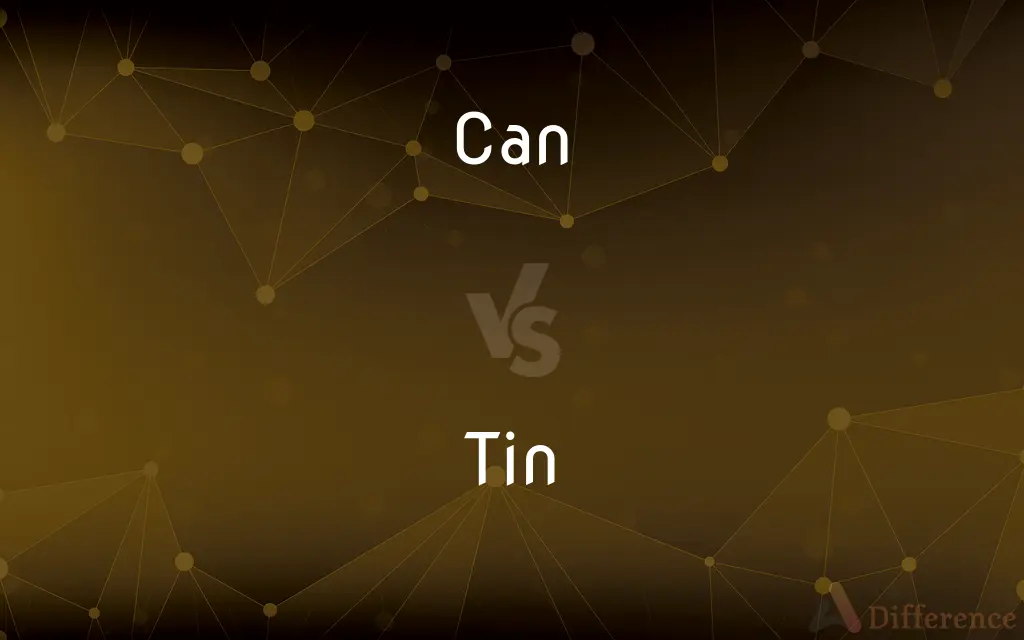Can vs. Tin — What's the Difference?
By Fiza Rafique & Urooj Arif — Updated on March 1, 2024
A can is a container typically made from metal used for storing and preserving food, beverages, or other products, while a tin is specifically made from tinplate and historically used for similar purposes but can also refer to the material itself.

Difference Between Can and Tin
Table of Contents
ADVERTISEMENT
Key Differences
Cans are cylindrical containers used for the distribution and storage of goods, commonly found in food and beverage packaging. They are made from various metals, including aluminum and steel, and are designed to be airtight to preserve the contents and prevent contamination. The use of cans dates back to the 19th century, with their development significantly impacting food preservation and safety. Cans are recyclable and valued for their durability and longevity, making them a sustainable packaging option.
The term "tin" can refer to both the container made from tinplate and the material itself. Tinplate is steel coated with a thin layer of tin to prevent rusting, combining the strength of steel with the corrosion resistance of tin. Historically, tin was widely used for cans and other containers before the advent of aluminum and other materials. Today, the term "tin can" is often used interchangeably with "can," although pure tin containers are less common. Tin is also valued in various industrial applications for its resistance to corrosion and low toxicity.
Both cans and tins serve the purpose of storing and preserving contents, but the materials and manufacturing processes may differ, reflecting advancements in technology and materials science. Cans made from aluminum or uncoated steel are lightweight and resistant to corrosion, making them suitable for carbonated beverages. On the other hand, tinplate cans are preferred for their aesthetic appeal and historical significance in packaging.
Can production has evolved to include lightweight, recyclable materials like aluminum, offering a modern solution to packaging needs with an emphasis on sustainability.
Tin usage, while less common in contemporary packaging due to alternatives like aluminum, remains important for specific applications requiring the unique properties of tinplate, such as certain food products and specialty items.
ADVERTISEMENT
Comparison Chart
Material
Made from aluminum, steel, or tinplate
Specifically refers to tinplate (steel coated with tin)
Usage
Broad use in food, beverages, and other products
Historically used for cans, now also refers to the material
Corrosion Resistance
Depends on the material; aluminum and tinplate are corrosion-resistant
Tin coating provides corrosion resistance to steel
Recyclability
Highly recyclable, especially aluminum cans
Tinplate is recyclable and can be reused without loss of quality
Historical Context
Came into widespread use in the 19th century
Tinplate used for centuries, with usage predating aluminum cans
Compare with Definitions
Can
A versatile container for food and beverages.
A soda can is made of aluminum.
Tin
A material used for coating steel cans.
Tinplate cans resist rusting and corrosion.
Can
Designed to be airtight for preservation.
Canned vegetables can last for years.
Tin
Used in various industrial applications.
Tin is used in soldering for its low toxicity.
Can
Lightweight and convenient for storage.
Soup cans are stackable and save space.
Tin
Can be recycled without loss of quality.
Tinplate from cans is recycled into new tinplate.
Can
Often made from recyclable materials.
Steel cans are recycled into new products.
Tin
Refers to containers made from tinplate.
Cookie tins often have decorative designs.
Can
Can be opened with a can opener or pull tab.
Many beverage cans come with a pull tab for easy opening.
Tin
Historically significant in packaging.
Early canned foods were preserved in tin cans.
Can
An airtight container, usually made of tin-coated iron, in which foods or beverages are preserved.
Tin
Tin is a chemical element with the symbol Sn (from Latin: stannum) and atomic number 50. Tin is a silvery metal that characteristically has a faint yellow hue.
Can
To seal in a can.
They canned air to sell as a novelty to tourists.
Tin
A container or box made of tin plate.
Can
A container used to carry and dispense water for plants (a watering can).
Tin
A silvery malleable metallic element that resists corrosion; used in many alloys and to coat other metals to prevent corrosion; obtained chiefly from cassiterite where it occurs as tin oxide
Can
A tin-plate canister, often cylindrical, for preserved foods such as fruit, meat, or fish.
Tin
Metal container for storing dry foods such as tea or flour
Can
A vessel or case of tinned iron or of sheet metal, of various forms, but usually cylindrical; as, a can of tomatoes; an oil can; a milk can.
Tin
Airtight sealed metal container for food or drink or paint etc.
Can
To preserve by putting in sealed cans
Tin
Plate with tin
Can
Airtight sealed metal container for food or drink or paint etc.
Can
A buoy with a round bottom and conical top
Common Curiosities
Can you recycle tin cans the same way as aluminum cans?
Yes, tin cans (tinplate) are recyclable and can be processed similarly to aluminum cans, often through the same recycling facilities.
What is the environmental impact of using cans versus tins?
Both aluminum and tinplate cans are recyclable and sustainable packaging options. However, recycling aluminum requires less energy compared to tinplate, potentially making aluminum cans a more environmentally friendly option in terms of energy consumption.
Why do some people still use the term "tin can" for aluminum cans?
The term "tin can" has historical roots and has remained in use as a general term for metal cans, even though the actual tin content may be minimal or nonexistent in modern cans.
What are the health implications of using cans vs. tins for food storage?
Both aluminum and tinplate cans are coated on the inside to prevent the metal from leaching into the food. The coatings are tested for safety and compliance with food contact regulations to minimize health risks.
Is there a taste difference between beverages in aluminum cans and tin cans?
The interior of cans is usually coated to prevent the metal from interacting with the beverage, minimizing taste differences. However, some people report a slight taste difference due to the type of coating used, not the metal itself.
Why are aluminum cans more common than tin cans now?
Aluminum cans are lighter, more corrosion-resistant, and cheaper to produce than tin cans, making them more popular in modern packaging.
How do you differentiate between a can and a tin in everyday language?
In everyday language, "can" is commonly used for beverage and food containers, regardless of the material, while "tin" often refers to containers for non-food items or is used historically.
Are there any contents that should only be stored in tin cans?
Certain acidic or alkaline foods may be better suited to tinplate cans for their corrosion resistance, although modern coatings and materials offer similar protections in aluminum cans.
Can aluminum and tinplate cans be used for the same types of products?
Yes, both types of cans can be used for a wide range of products, including food, beverages, and other goods. The choice between aluminum and tinplate often depends on factors like cost, product compatibility, and manufacturer preference.
How has consumer preference influenced the use of cans vs. tins in packaging?
Consumer preference for more sustainable and convenient packaging has led to an increase in the use of aluminum cans, which are lighter and more easily recyclable. However, tinplate cans are still preferred for certain products due to their classic appearance and robustness.
How has the use of tin changed over time?
While the direct use of tin in cans has decreased due to the rise of aluminum and improved steel coatings, tin remains important in alloys and coatings for its corrosion resistance and non-toxic properties.
What is the significance of the tin coating on steel cans?
The tin coating on steel (tinplate) provides additional resistance to rust and corrosion, extending the shelf life of canned goods. Tin is more resistant to corrosion than steel, especially against certain food products.
Are there any innovative uses for recycled cans and tins?
Recycled cans and tins are used in a variety of innovative applications, from creating new packaging materials to being repurposed into household items, art projects, and even construction materials in some cases.
How does the manufacturing process differ between aluminum cans and tinplate cans?
Aluminum cans are typically made from a single piece of aluminum through a process called drawing and ironing, while tinplate cans are made by coating sheets of steel with tin, then cutting, shaping, and welding them into cans.
How do you properly dispose of aluminum and tinplate cans?
Both should be recycled according to local guidelines. Aluminum cans can often be recycled curbside, while tinplate cans may need to be taken to a specific recycling facility. It's important to clean and, if required, separate the materials before recycling.
Share Your Discovery

Previous Comparison
Candidature vs. Candidacy
Next Comparison
Limitation vs. ConstraintAuthor Spotlight
Written by
Fiza RafiqueFiza Rafique is a skilled content writer at AskDifference.com, where she meticulously refines and enhances written pieces. Drawing from her vast editorial expertise, Fiza ensures clarity, accuracy, and precision in every article. Passionate about language, she continually seeks to elevate the quality of content for readers worldwide.
Co-written by
Urooj ArifUrooj is a skilled content writer at Ask Difference, known for her exceptional ability to simplify complex topics into engaging and informative content. With a passion for research and a flair for clear, concise writing, she consistently delivers articles that resonate with our diverse audience.














































